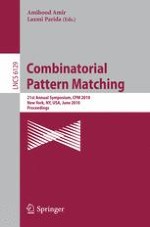2010 | Buch
Combinatorial Pattern Matching
21st Annual Symposium, CPM 2010, New York, NY, USA, June 21-23, 2010. Proceedings
herausgegeben von: Amihood Amir, Laxmi Parida
Verlag: Springer Berlin Heidelberg
Buchreihe : Lecture Notes in Computer Science
